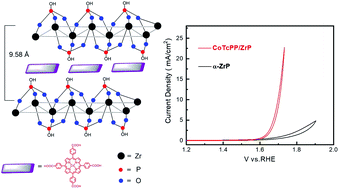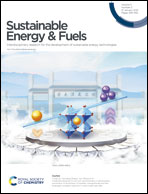Cobalt porphyrin intercalation into zirconium phosphate layers for electrochemical water oxidation†
Abstract
A cobalt porphyrin molecule, namely CoTcPP (TcPP = the dianion of meso-tetra(4-carboxyphenyl)porphyrin), is intercalated into zirconium phosphate (ZrP) layers as an effective way to heterogenize a porphyrin-based molecular electrocatalyst. Fourier-transform infrared (FT-IR) spectroscopy, X-ray powder diffraction (XRPD) measurements, UV-Vis spectroscopy, elemental mapping, energy dispersive X-ray (EDX) analysis, inductively coupled plasma mass spectrometry (ICP-MS) and X-ray photoelectron spectroscopy (XPS) were utilized to determine the successful intercalation of CoTcPP into ZrP. While the CoTcPP molecule is not amendable to be used as a heterogeneous catalyst in basic environment due to the carboxylic groups, the intercalated species (CoTcPP/ZrP) is effective towards water oxidation from KOH aqueous solution when utilized as a heterogeneous electrocatalyst and shows remarkable catalytic durability. Electrochemical results show that CoTcPP/ZrP requires an overpotential of 0.467 V to achieve a current density of 10 mA cm−2 while the pristine α-ZrP shows negligible electrocatalytic OER behavior.



 Please wait while we load your content...
Please wait while we load your content...
